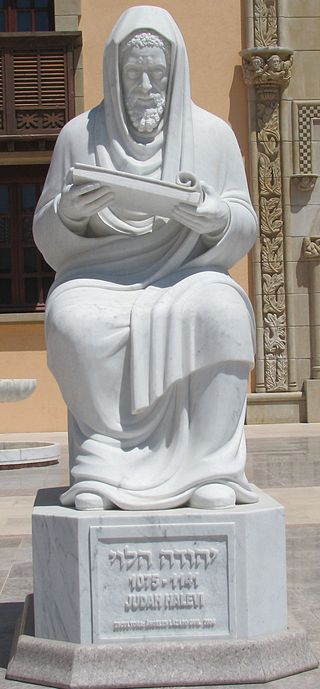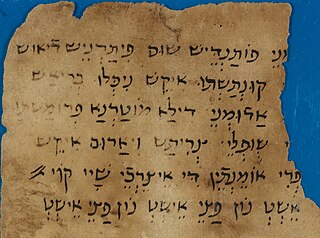Related Research Articles

Rabbinic literature, in its broadest sense, is the entire spectrum of rabbinic writings throughout Jewish history. However, the term often refers specifically to literature from the Talmudic era, as opposed to medieval and modern rabbinic writings, and thus corresponds with the Hebrew term Sifrut Chazal. This more specific sense of "Rabbinic literature"—referring to the Talmudim, Midrashim, and related writings, but hardly ever to later texts—is how the term is generally intended when used in contemporary academic writing. The terms mefareshim and parshanim (commentaries/commentators) almost always refer to later, post-Talmudic writers of rabbinic glosses on Biblical and Talmudic texts.

Joseph ben Ephraim Karo, also spelled Yosef Caro, or Qaro, was the author of the last great codification of Jewish law, the Beit Yosef, and its popular analogue, the Shulhan Arukh. To this end he is often referred to as HaMechaber or "The Author" and as Maran or "Our Master".

Judah Halevi was a Sephardic Jewish poet, physician and philosopher. He was born in Al-Andalus, either in Toledo or Tudela, in 1075. He is thought to have died in 1141, in either Jerusalem, at that point the Crusader Kingdom of Jerusalem, or in Alexandria, Egypt.

Joseph Albo was a Jewish philosopher and rabbi who lived in Spain during the fifteenth century, known chiefly as the author of Sefer ha-Ikkarim, the classic work on the fundamentals of Judaism.
Rishonim were the leading rabbis and poskim who lived approximately during the 11th to 15th centuries, in the era before the writing of the Shulchan Aruch and following the Geonim. Rabbinic scholars subsequent to the Shulchan Aruch are generally known as acharonim.
Aharon ben Joseph haLevi, known by his Hebrew acronym Ra'aH, was a medieval rabbi, Talmudic scholar and Halakhist.
Moshe haDarshan was chief of the yeshiva of Narbonne, and perhaps the founder of Jewish exegetical studies in France. Along with Rashi, his writings are often cited as the first extant writings in Zarphatic, the Judæo-French language.

Judeo-Latin is the use by Jews of the Hebrew alphabet to write Latin. The term was coined by Cecil Roth to describe a small corpus of texts from the Middle Ages. In the Middle Ages, there was no Judeo-Latin in the sense of "an ethnodialect used by Jews on a regular basis to communicate among themselves", and the existence of such a Jewish language under the Roman Empire is pure conjecture.
Zerachiah ben Isaac ha-Levi Gerondi, called the ReZaH, RaZBI or Baal Ha-Maor was born about 1115 in the town of Gerona, Catalonia, Spain – hence the name Gerondi – and died after 1186 in Lunel. He was a famous rabbi, Torah and Talmud commentator and a poet.
Sefer ha-Chinuch is a Jewish rabbinic text which systematically discusses the 613 commandments of the Torah. It was published anonymously in 13th-century Spain.

Moses ben Joseph di Trani the Elder, known by his acronym Mabit was a 16th-century rabbi in Safed.
Eliezer ben Yoel HaLevi of Bonn was a Rabbinic scholar in Germany. He had a significant influence on Asher ben Jehiel. As a Rishon, he was prominent amongst the Tosafists of the middle-ages, and was a signatory to the Takkanot Shum. In the course of his long life he wandered from place to place: Bonn, Worms, Würzburg, Mainz, Cologne, Regensburg, and throughout France and Lombardy.
Abraham ben Isaac of Narbonne (c. 1080-85 – 1158) was a Provençal rabbi, also known as Raavad II, and author of the halachic work Ha-Eshkol.
Shem Tov ibn Shem Tov was a Spanish kabbalist and fierce opponent of rationalistic philosophy.

Jonah ben Abraham Gerondi, also known as Jonah of Girona and Rabbeinu Yonah, was a Catalan rabbi and moralist, cousin of Nahmanides. He is most famous for his ethical work The Gates of Repentance.

Sifrei Kodesh, commonly referred to as sefarim, or in its singular form, sefer, are books of Jewish religious literature and are viewed by religious Jews as sacred. These are generally works of Torah literature, i.e. Tanakh and all works that expound on it, including the Mishnah, Midrash, Talmud, and all works of halakha, Musar, Hasidism, Kabbalah, or machshavah. Historically, sifrei kodesh were generally written in Hebrew with some in Judeo-Aramaic or Arabic, although in recent years, thousands of titles in other languages, most notably English, were published. An alternative spelling for 'sefarim' is seforim.
Aaron ha-Levi of Barcelona was a Spanish Talmudist of the end of the thirteenth century; author of the first book of religious instruction among the Jews of the Middle Ages. Though his work the Sefer ha-Chinuch was well known, having been repeatedly commented on and republished in more than a dozen editions, it was reserved for Rosin to discover anything accurate concerning the personality of the author. The book itself is anonymous; and the statement by Gedaliah ibn Yaḥyah, that its author was the celebrated Talmudist Aaron ben Joseph ha-Levi, has been generally accepted. It is now, however, certain that the author was a Spanish instructor of youth, of modest position, one who had contented himself with but the faintest allusion to his own identity in symbolically applying to himself the verse Mal. ii. 5, at the end of the prefatory letter to the book; in an old Midrash this verse is referred to Aaron. He lays no claim to original research. The book was simply intended to impart to Jewish youth a knowledge of the Law, and to present in simple form the principles of Judaism to the unlearned layman. The writer seems to have had this lay-public always before him; and his work is in this respect different from that of his predecessors, Maimonides, Naḥmanides, and Moses of Coucy, from whose works he liberally draws. The Sefer ha-Chinuch is an enumeration of the six hundred and thirteen affirmative and negative precepts of the Mosaic Law, arranged in the order of the weekly lessons (parashot), with their ethical and halakic aspects, based upon rabbinical tradition of the Talmudic and post-Talmudic periods, for which latter feature he relies upon Alfasi, Maimonides, and Naḥmanides as main authorities. His chief and original merit is displayed in the ingenuity and religious fervor with which he dwells upon the ethical side of the Law, avoiding most admirably all abstruse philosophical and mystical theories, such as are only too abundant in his guides, Maimonides and Naḥmanides. The following are some specimens of his method. Upon the precept concerning the treading ox the Sefer ha-Chinuch remarks:
"It is the duty of man to accustom himself to show kindness, compassion, and consideration to his fellow creatures. When we therefore treat considerately even the animals given for our use, and withdraw not from them some of the fruits of what their labor obtains for us, we educate our soul thereby to be all the kinder to our fellow men, and accustom ourselves not to withhold from them what is their due, but to allow them to enjoy with us the result of that to which they have contributed".
Zechariah (Yaḥya) al-Ḍāhirī, often spelled Zechariah al-Dhahiri, was the son of Saʻīd (Saʻadia) al-Ḍāhirī, from Kawkaban, in the District of al-Mahwit, Yemen, a place north-west of Sana’a. He is recognized as one of the most gifted Yemenite Jewish poets and rabbinic scholars who left Yemen in search of a better livelihood, travelling to Calicut and Cochin in India, Hormuz in Persia, Basra and Irbīl in Babylonia, Bursa and Istanbul in Anatolia, Rome in Italy, Aleppo and Damascus in Syria, Safed and Tiberias, as well as Jerusalem and Hebron in the Land of Israel, Sidon in Ottoman Lebanon and Egypt, and finally unto Abyssinia where he returned to Yemen by crossing the Erythraean Sea and alighting at a port city near Mocha, Yemen. He wrote extensively about his travels and experiences in these places, which he penned in a Hebrew rhymed prose narrative, and eventually publishing them in a book which he called Sefer HaMusar, in circa 1580.
Rabbi Samuel ben Natronai also known as RaSHBaT was a 12th-century German Tosafist.
References
- 1 2 3 Jewish Virtual Library, SAADIAH BEN JOSEPH HA-LEVI
- ↑ Saʻadia ben Joseph, Joel Müller (28 September 1897). "Sefer ha-yerushot: ʻim yeter ha-mikhtavim be-divre ha-halakhah be-ʻAravit uve-ʻIvrit uve-Aramit". Ernest Leroux. Retrieved 28 September 2017– via Internet Archive.